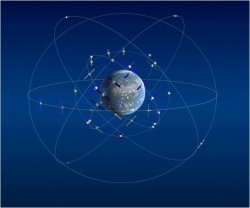If you wish to contribute or participate in the discussions about articles you are invited to contact the Editor
BeiDou Space Segment
| COMPASS | |
|---|---|
| Title | BeiDou Space Segment |
| Edited by | GMV |
| Level | Basic |
| Year of Publication | 2011 |
The COMPASS Space Segment will consist of a constellation of 35 satellites, which include 5 geostationary orbit (GEO) satellites and 30 non-GSO satellites. The system is currently under development evolving from a regional system called BeiDou-1, and in the first phase will provide global navigation services by 2020, similarly to the GPS, GLONASS or Galileo systems[1].
COMPASS Space Segment
The COMPASS Space Segment will consist of a constellation of 35 satellites, which include 5 geostationary orbit (GEO) satellites and 30 non-GSO satellites; 27 in Medium Earth Orbit (MEO) and 3 in Inclined Geosynchronous Orbit (IGSO), w5th a worldwide coverage.[2][3]
The system is to be deployed in two stages; the launches for the first phase will be completed by 2012[1] and will consist of 14 satellites aiming at the Asia-Pacific region,[2] followed by the deployment of the global system by 2020.[1]
As of December 2011, ten Compass satellites have been successfully launched. The first eight of which completed the deployment foreseen for the first phase of BeiDou-2.[1][2][4] Also in December 2011, the COMPASS system went into operation on a trial basis providing initial passive positioning navigation and timing services for the whole Asia-Pacific region with a constellation of 10 satellites (5 GEO satellites and 5 IGSO satellites)[5][3]. During 2012, the system is going to launch another 6 satellites[2][5].
| Date | Launcher | Satellite | Orbit | Usable | System |
|---|---|---|---|---|---|
| 31/10/2000 | LM-3A | BeiDou-1A | GEO 59°E | ? | Beidou-1 |
| 21/12/2000 | LM-3A | BeiDou-1B | GEO 80°E | Yes | |
| 25/5/2003 | LM-3A | BeiDou-1C | GEO 110.5°E | Yes | |
| 3/2/2007 | LM-3A | BeiDou-1D | supersync orbit | No | |
| 14/4/2007 | LM-3A | Compass-M1 | MEO ~21,500 km | Testing only | Compass |
| 15/4/2009 | LM-3C | Compass-G2 | GEO Drifting | No | |
| 17/1/2010 | LM-3C | Compass-G1 | GEO 144.5°E | Yes | |
| 2/6/2010 | LM-3C | Compass-G3 | GEO 84°E | Yes | |
| 1/8/2010 | LM-3A | Compass-IGSO1 | IGSO 118°E incl 55° | Yes | |
| 1/11/2010 | LM-3C | Compass-G4 | GEO 160°E | Yes | |
| 18/12/2010 | LM-3A | Compass-IGSO2 | IGSO 118°E incl 55° | Yes | |
| 10/4/2011 | LM-3A | Compass-IGSO3 | IGSO 118°E incl 55°, 200~35,991km | Yes | |
| 26/07/2011 | LM-3A | Compass-IGSO4 | 35695 x 35865 km incl 55.2°, 80° to 112°E | Yes (?) | |
| 02/12/2011 | LM-3A | Compass-IGSO5 | 35712 x 35873 km incl 55.2°, 79° to 110°E | Yes (?) |
The nominal constellation includes 35 satellites, 5 GEOs, 3 IGSOs and 27 MEOs. The number of IGSO orbits is 3, with one IGSO per plane. The intersection node is 118E. The MEOs are deployed as a Walker constellation; 24 MEOs in 3 planes plus 3 spares. The orbital parameters of the final constellation are shown in the following table:[2]
| Orbit parmts. | GEO | IGSO | MEO |
|---|---|---|---|
| Semi-Major Axis (Km) | 42164 | 42164 | 27878 |
| Eccentricity | 0 | 0 | 0 |
| Inclination (deg) | 0 | 55 | 55 |
| RAAN (deg) | 158.75E, 180E, 210.5E, 240E,260E | 218E,98E,338E | -- |
| Argument Perigee | 0 | 0 | |
| Mean anomaly (deg) | 0 | 218E:0,98E:120,338E:240 | |
| # Sats | 5 | 3 | 27 |
| # Planes | 1 | 3 | 3 |
Notes
References
- ^ a b c d Cite error: Invalid
<ref>tag; no text was provided for refs namedChinese_today - ^ a b c d e China Satellite Navigation Office, Development of BeiDou Navigation Satellite System, Munich Satellite Navigation Summit, 2011 Cite error: Invalid
<ref>tag; name "BEIDOU_MUNICH_2011" defined multiple times with different content Cite error: Invalid<ref>tag; name "BEIDOU_MUNICH_2011" defined multiple times with different content - ^ a b COMPASS Navigation system in Wikipedia
- ^ China completes basic Beidou (Compass) Navigation Satellite System, 2011-04-10 by Globaltimes.cn
- ^ a b Satellite navigation system launched, China Daily Europe, December 2011.
- ^ Beidou Navigation System in Wikipedia

